Cultivating Sustainability: The Power of Partnership with LEAF
In an era where climate change and environmental degradation pose significant challenges, the agricultural sector has a pivotal role to play in fostering sustainability. One organisation at the forefront of this movement is LEAF (Linking Environment And Farming). With a passionate commitment to promoting sustainable farming practices, LEAF has been driving positive change for over 30 years.
This blog post delves into LEAF’s mission, their initiatives, and the transformative impact they create by partnering with agricultural stakeholders worldwide.
Our work with LEAF:
As a LEAF Demonstration farm and LEAF Marque producer, we are very proud of the work the LEAF team do to encourage other farmers to take a more sustainable approach to their farms.
In 2021, we were awarded a Queen’s Award for our industry leading approach to sustainability: from our commitment to carbon and plastic neutrality, to our LEAF Marque standards, to Duncan’s work monitoring and increasing the carbon stored in our soils.
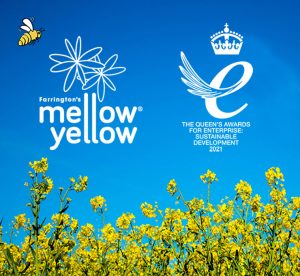

Understanding LEAF’s Mission:
LEAF’s core mission revolves around connecting farmers and consumers to promote environmentally responsible and sustainable food production. Established in 1991 in the United Kingdom, LEAF has grown into an international organisation, spreading its ethos of sustainable farming far and wide. Their approach combines practical, science-based solutions with community engagement, fostering a holistic approach to agricultural sustainability.
Integrated Farm Management (IFM):
At the heart of LEAF’s philosophy lies Integrated Farm Management (IFM). It encourages farmers to adopt best practices that enhance biodiversity, minimise chemical usage, and improve energy efficiency. IFM is made up of nine sections:
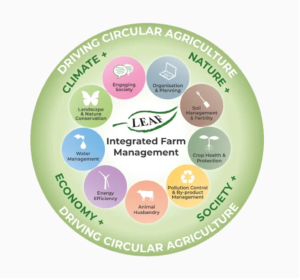
1. Organisation and Planning
2. Soil Management and Fertility
3. Crop Health and Protection
4. Pollution Control and By-product Management
5. Animal Husbandry
6. Energy Efficiency
7. Water Management
8. Landscape and Nature Conservation
9. Engaging Society
By embracing IFM, farmers can optimise their land’s potential while safeguarding the natural resources that sustain us all.
The LEAF Marque:
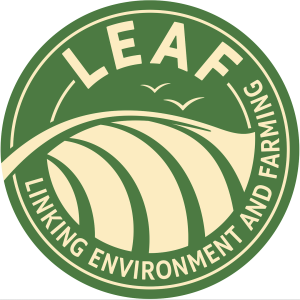
One of LEAF’s most recognised initiatives is the LEAF Marque, a certification scheme that identifies sustainably produced food to consumers. By displaying the LEAF Marque logo on our Mellow Yellow products, it assures consumers that they come from farms practicing environmentally responsible methods. This strengthens trust between consumers and farmers, driving demand for sustainable products and incentivising farmers to adopt more sustainable practices.
Farm Demonstration Network:
People have always been at the heart of LEAF’s vision of a world that is farming, eating and living sustainably. Building knowledge and understanding of sustainable farming helps highlight the connections between all living things – soil, plants, animals and people.
As a LEAF Demonstration Farm and LEAF Open Farm Sunday host farmer, we welcome people from all walks of life to experience farming first hand. Bringing people closer to farming and how their food is produced, encourages individuals to make sustainable choices in their everyday lives.
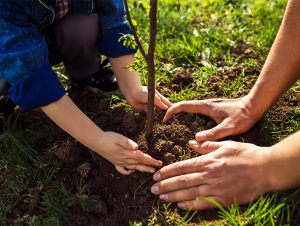
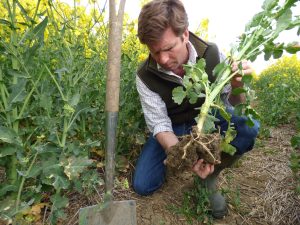
LEAF’s dedication to promoting sustainable farming practices has made a substantial impact on the agricultural sector and beyond. By providing farmers with the tools to embrace Integrated Farm Management, offering the LEAF Marque certification to assure consumers and fostering collaborations through their vast network, LEAF has become a driving force for positive change in 27 countries with over 900 LEAF Marque certified businesses worldwide, including over 40% of UK grown fruit and vegetables grown on LEAF Marque farms.
Working alongside LEAF, agricultural stakeholders worldwide are adopting sustainable practices, enhancing biodiversity and conserving vital natural resources. As we collectively address the challenges of climate change, LEAF’s commitment to cultivating sustainability serves as an inspiring model for organisations, farmers, and consumers alike. Together, with organisations like LEAF leading the way, we can build a more sustainable future for generations to come.
Our Journey to Carbon Neutrality
In a world where environmental concerns have reached a critical point, companies embracing sustainability become beacons of hope. At Farrington’s Mellow Yellow, we have taken a remarkable step towards mitigating our environmental impact. With a resolute commitment to sustainability, we have achieved carbon neutrality while collaborating with esteemed organisations like LEAF (Linking Environment And Farming) and One Carbon World. This blog post delves into Farrington’s Mellow Yellow’s remarkable journey towards carbon neutrality and our partnerships that contribute to a greener, more sustainable future.
The Vision for Sustainability
Even before launching Mellow Yellow, sustainability was at the heart of Duncan Farrington’s farming practises. Working to LEAF Integrated Farm Management principles, he used energy efficient machinery, planted trees hedges and wildflower areas to increase biodiversity, and recognised the importance looking after soils in growing the foods we eat. The principles of doing the right things with Mellow Yellow have always been deeply rooted in our commitment to the environment. From the very beginning, we envisioned creating a company that not only provided high-quality oils and dressings, but also operated responsibly, leaving a minimal ecological footprint. With this vision in mind, we set out on a journey to become carbon neutral.
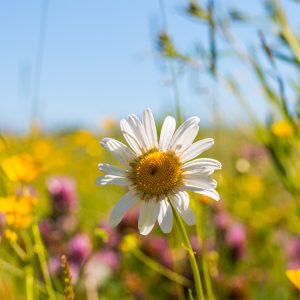
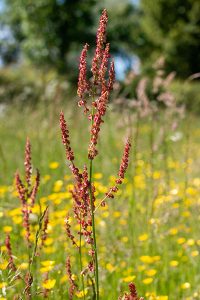
Becoming Carbon Neutral
Achieving carbon neutrality is no small feat, especially for a company operating in the agricultural sector. We adopted a multi-faceted approach to reduce our carbon emissions and offset the remaining unavoidable emissions. Through meticulous planning, innovative technologies, and sustainable practices, we managed to significantly decrease our carbon footprint.
We invested in energy-efficient machinery, optimised transportation routes and implemented renewable energy sources to reduce emissions throughout our supply chain. We also continue to focus on responsible land management and biodiversity conservation on our’s and our grower farms, supplying rapeseed to our factory, through the LEAF Marque accreditation .
Around the edges of our fields we have wildflowers. In these wildflower meadow margins, as they are known, we have a huge variety of different plant species, insects and birds, improving biodiversity and creating wildlife habitats. As well as providing habitats for insects and improving biodiversity, our wildflowers also help us out on the farm. The wildflowers attract pollinators, which are essential for crop pollination, plus the insects in the wildflowers act as a natural pest control on our crops.
On our roofs we have installed solar panels which generate around 50% of the electricity used in the business. This is combined with installing the latest LED lighting and most efficient compressor to run the bottling machinery, both of which reduce the amount of electricity used. We also encourage everyone to do the simple things like turning lights off when we they are not needed.
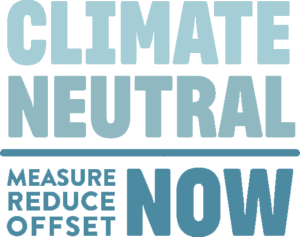

Collaborations with LEAF, One Carbon World and AgricaptureCO2
Farrington Oils’ journey towards sustainability was further strengthened by our collaborations with LEAF and One Carbon World. LEAF, a renowned organisation, works towards promoting sustainable farming practices that are beneficial for both the environment and the farmers. Through this partnership, we gained valuable insights and guidance on adopting regenerative agricultural practices that boost soil health and sequester carbon.
One Carbon World is a resource partner of the United Nations Climate Neutral Now initiative, is committed to emission reduction strategies and projects that meet the highest standards, reduce carbon emissions, and contribute to sustainable development. One carbon world played a crucial role in Mellow Yellow’s mission to achieve carbon neutrality. Carbon neutral means achieving net zero carbon dioxide emissions by balancing carbon emissions with carbon removal (often through carbon offsets).
To date our carbon neutrality has been achieved with the help of One Carbon World meticulously calculating carbon footprint from our years of data collected, whilst we have been trying to reduce the total emissions we generate. The net emissions are then offset through United Nations approved schemes.
As a sustainable farm-based business there is an opportunity to offset all of our emissions internally through the carbon dioxide absorbed in the soils we manage on our farm through a process called Carbon Sequestration. This is an area of interest that Duncan Farrington has looked at for over twenty years of analysis of his soils, but it is not yet recognised internationally as an accepted measure to reduce potential greenhouse gas emissions. Since becoming certified as Carbon Neutral, Farrington Oils have been invited to be the British case study in a pan European study called AgricaptureCO2 looking into the measurement and verification of soil carbon content and general farm biodiversity. Through this collaborative project it is hoped that sustainable farming can officially become part of the global solution to help reverse climate change.
Why we don’t plough
The plough turns over and breaks up the soil surface to create a seed bed to plant crops in. The advantages are that it provides soils free from weeds, provides good conditions and soil structure for plants to grow in. It also gives a nutritional boost to the plants as bacteria breakdown minerals for the plants to feed off.
However, ploughing can also be detrimental to the environment for several reasons. Firstly, it disrupts the soil structure, leading to erosion and loss of valuable topsoil, which affects soil fertility and water retention. Secondly, ploughing releases carbon dioxide stored in the soil into the atmosphere, contributing to greenhouse gas emissions and climate change.
Sustainable farming can help preserve soil health, reduce carbon emissions and promote environmental conservation.
Empowering Consumers
In addition to our internal efforts, we have also made it a priority to educate and empower consumers to make sustainable choices. We transparently share our sustainability journey with our customers, encouraging you to join the movement towards a greener future. By supporting the Mellow Yellow brand, you become part of a collective effort to combat climate change and preserve the planet for future generations.
Our remarkable achievement at Farrington Oils of becoming carbon neutral is a testament to the power of dedication, collaboration, and innovation in the face of environmental challenges. Our partnerships with LEAF, One Carbon World and AgricaptureCO2 have proven that collective action can make a meaningful impact in the fight against climate change.
Let’s continue to work together towards a carbon-neutral and sustainable future.
Every year at the start of August, farmers are encouraged to share their day online as part of 24 Hours in Farming #Farm24. We took part again this year and shared all the goings on from Bottom Farm.
First, we headed out to find Marvin cultivating. This field was growing wheat this year which has now been harvested, we leave the wheat stubble in the field to biodegrade and nourish the soil. We are planning on planting beans in this field in October and beans need to be planted quite deep into the ground. Marvin has to cultivate the soil to loosen the top layer to make it possible for us to plant the beans. This is a big field and the cultivator needs to be driven quite slowly so this will take the majority of the day!
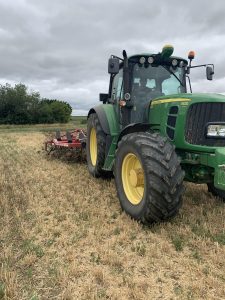
We then headed back to the farm yard, passing the combine harvester which is having a rest until the spring barley is ready to be harvested.
![]()
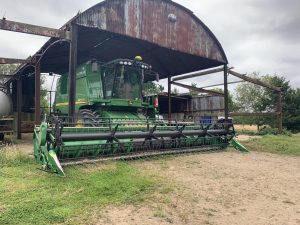
Here are the wild flowers we have growing around our spring barley. These flowers provide habitats for insects and is great for pollinators.
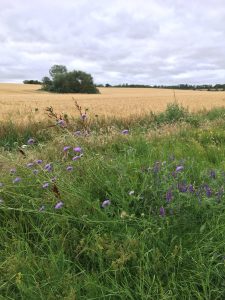
We even have these beautiful daisies in the wildflower meadow margins, and Duncan explained these are actually chamomile for making into tea!
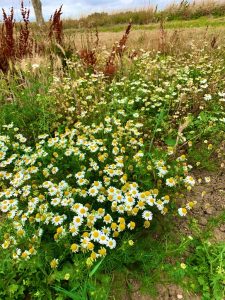
The last stop on our way back to the farmyard was these trees. Duncan planted them back in 1989 and they are just a few of the 8000 trees he has planted on the farm over the years.
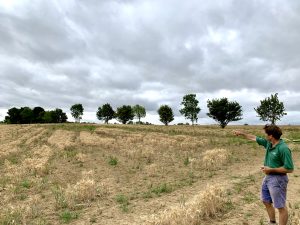
Heading into our rapeseed oil production area, we watched the team pressing and bottling our Mellow Yellow Rapeseed Oil. We cold press our rapeseed on our farm. Our presses run 24/7 to produce Mellow Yellow Rapeseed Oil for kitchens up and down the country! We call it the process of no process. Simply sow, grow, press and bottle!
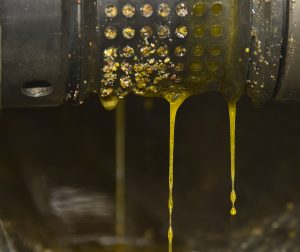
We harvested our rapeseed a few weeks ago and this what the little seeds look like. They’re bright yellow inside and packed full of delicious and nutritious oil!
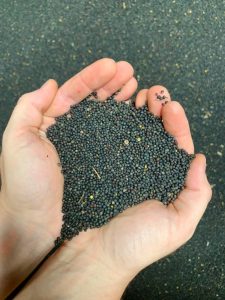
After lunch, Duncan headed out to do some mowing. Tidying up the edges of fields already combined and making sure the various public footpaths we have going through the farm are clear and accessible for people on their daily walks!
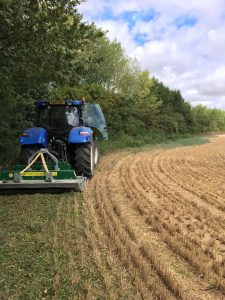
Before we harvest the wheat, we need to check the moisture content, still a few more days of sunshine needed for this field! Duncan is winnowing here – blowing air through the wheat to remove the chaff!
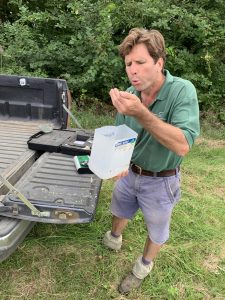
We then left Marvin finishing off the cultivating and that was our day!
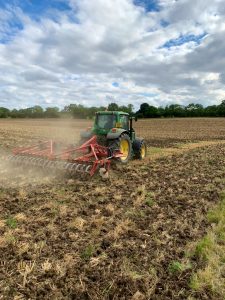
We had a great time sharing our day on the farm and we hope you enjoyed getting an insight into British farming! See you next year!
What is carbon sequestration?
“Carbon sequestration is the long-term removal of carbon dioxide from the atmosphere to be stored in plants, soils, geologic formations or oceans.”
This sentence very simply defines what carbon sequestration is, but I will explain a bit more about what it actually means and how soils and sustainable farming practices can have a major impact on reducing global warming by reducing the carbon dioxide (CO2) levels in the atmosphere.
Soil carbon sequestration is a natural process powered by growing plants, through the process of photosynthesis. Plants photosynthesise with the energy from sunlight, taking CO2 out of the atmosphere and converting this into new plant material, both above and below the soil surface, locking up the carbon and releasing the oxygen back to the atmosphere. The process works in symbiosis with the minerals, water, bacteria, fungi and other organisms in the soil. Plants grow, die and decay, feeding the soil and the life within it. Over the long term, CO2 is removed from the atmosphere, locked into the soil and, stored in the plants. This is carbon sequestration and the soil is known as a carbon sink.
What is soil?
Soils are naturally made up of four different components, a typical soil consists of:
50% Mineral
20-25% Water
20-25% Air
1 to 12% Organic matter
Obviously, the specific percentages will vary from one soil to another and whether or not it is in wet or dry conditions for example. In winter soils will contain more water than in the summer. The organic matter is made up from all the living and dead material: bacteria, plant roots, dead leaf litter and animal manure for example. This organic matter is full of carbon that is locked in the soil. Different soils will have different soil organic matter (SOM) contents and therefore different carbon contents. For example, a sandy soil will have a low SOM of around 1%, where as a peat-based soil will be at the top end, with clay soils somewhere in between.
A bit of soil history
Around 10,000 years ago man evolved from being a hunter gatherer to a farmer as they started growing crops and grazing animals. They managed the soils, changing the natural habitat to one more favourable to their needs. Right from the first farmers, man has not been very successful at looking after our soils. In fact, every empire in human history has eventually failed due to starvation, mainly bought about by soil degradation. From the Roman Empire, to the more recent collapse of the Soviet Union.
President Franklin Roosevelt once stated, “A nation that destroys its soil, destroys itself.” Wise words indeed, based on thousands of years of proof. However, when Roosevelt made this statement, he was probably thinking of the dust bowls in the mid-west of the American prairies and the loss of the natural habitat caused by farmers ploughing up their land to grow crops. He was very aware of the nutritious soil literally being blown away and was no doubt aware that unless farming practices changed, in time this land would not be able to produce food. But he was probably not aware that the general degradation of the soil was also releasing many thousands of tonnes of CO2 into the atmosphere, adding to what we know today as Global Warming.
Traditionally farmers plough the land, a process to turn the soil over to create good conditions in which to plant the following crop or pasture. However, when the soil is moved intensely as it is in ploughing, the carbon that is locked into that soil is suddenly exposed to our oxygen-rich atmosphere, resulting in the carbon combining with the oxygen to make carbon dioxide, which is released into the atmosphere. At this point the soil changes from being a carbon sink (removing CO2 from the atmosphere) to become a carbon source (releasing CO2 into the atmosphere). Over a few short decades, soils will lose their carbon content and thus reduce the soil organic matter, not only releasing global warming CO2, but also making the soil less nutritious and resilient to extreme weather conditions, which is not good for the farmer.
How are we improving our soils on Bottom Farm?
There is a better way we can grow our crops and graze our animals, using sustainable practises carried out by the likes of LEAF farmers (Linking Environment And Farming). These sustainable farming practises have three crucial but simple requirements to make soils healthy:
– Reduce soil disturbance from intensive cultivation and ploughing
– Keep something growing in the soil all year
– Vary the crops and livestock grown on the soil
By reducing cultivation, and especially ploughing of the soil, the loss of CO2 is greatly reduced. By keeping something growing in the soil as long as possible, not only are the plants utilising the power of the sun, photosynthesising and actively absorbing CO2 from the atmosphere, but the roots are feeding all the microbes in the soil to keep a healthy biodiversity. Finally, by varying the crops and livestock grown on the soil, the farmer better mimics what would happen in nature keeping the soil in good health.
If farmers follow these simple principles, they can again turn the soil back into a carbon sink, sequestering carbon in the soil and increasing the soil organic matter. I have done this on our farm over the last two decades and on one field which I have been monitoring, I have increased the soil organic matter from 3.8% to 6.3% between 2002 and 2016. To put this into context, if every farmer around the world practiced sustainable soil principles, our soils have the ability to remove 1 trillion tonnes of CO2 from the atmosphere, taking us back to pre-industrial levels. So, the prize is extremely big and very worthwhile aiming for.
On the 8th August, we took part in 24 Hours in Farming, the agricultural industry’s biggest online event, which highlights the pride of the nation’s food producers and encourages farmers to show the general public a typical working day through the power of social media using the hashtag #Farm24. Starting at 5am on Thursday 8th and finishing at 5am on Friday 9th, this 24 hour event encouraged British farmers to share an insight into their day to show consumers the effort and care that goes into producing their food.
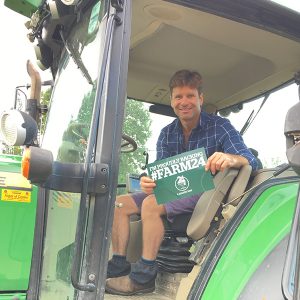
Duncan Farrington ready for #Farm24
Starting first thing in the morning, Duncan had to move all the barley in the barn back as far as possible, to give plenty of room for the barley he was due to the harvest throughout the day.
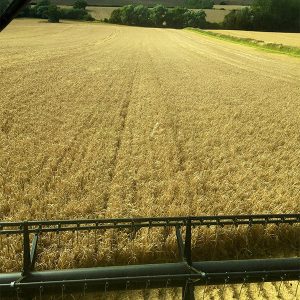
View from inside the combine harvester
Meanwhile, Robert (Duncan’s father) and Marvin (our farm worker) started preparing the combine harvester. This involved cleaning the windscreen, blowing the dust from the combine to reduce fire risk, setting up the GPS and getting the combine ready for a busy day. Once everything was set, Marvin starting combining. We use GPS to pinpoint our location in the field and steer the combine through the field, ensuring that each length of the field is harvested as efficiently as possible, reducing fuel usage and taking less time.
We were harvesting spring barley on this particular day. This year our spring barley was destined to be made into malt for beer, so a fairly important crop in our opinion!
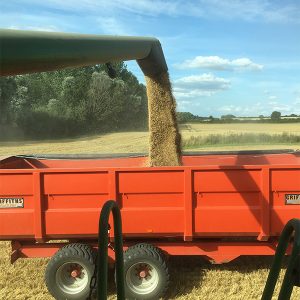
Barley being unloaded into the trailer
Whilst Marvin drove the combine, Duncan and Robert took it in turns to fill a trailer load of harvested barley from the combine and take it back to the farm yard and tip it into the barn. By having both Duncan and Robert do this, they were able to keep up with the speed Marvin was harvesting at so the combine didn’t have to stop at any point.
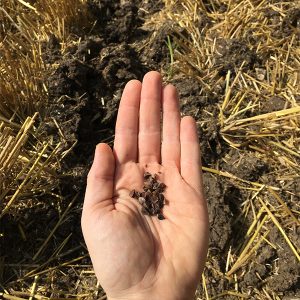
Cover crop seeds – buckwheat & phacelia
We visited another field on Bottom Farm, this one was harvested a few days previously and then planted with cover crops. We use cover crops to improve the health of our soil, but the key benefit is the fact that they absorb CO2 from the atmosphere and store the carbon in the soil (more info here). We planted buckwheat (the bigger, pyramid shaped seeds) which scavenge for phosphate and helps young plants’ root development. We also planted phacelia (the tiny seeds) which have fibrous roots for soil structure. On the same day as #Farm24, the UN also released their latest climate change report, which highlighted the importance of soil and storing carbon from the atmosphere in soil, which is exactly what our cover crops do!
Whilst Duncan was busy with harvest, his wife Eli jumped in a tractor and rolled the fields of cover crops. Rolling smooths the field and ensures the seeds are pushed into a good soil base to give them the best chance for growing.
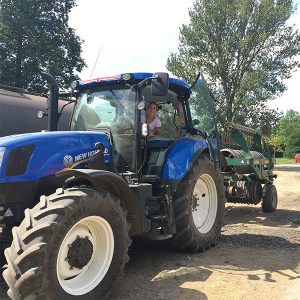
Eli Farrington in tractor
Next, we headed over to the Mellow Yellow production barn. Mellow Yellow Rapeseed Oil is grown, pressed and bottled on the farm. First of all, the seeds go into big yellow hoppers which feeds the seed into the presses. The seed is then cold pressed which involves being gently squeezed until the yellow oil is released. The seed husk is not wasted, it is shaped into pellets and sold to local farmers as high quality animal feed for cattle, pigs and sheep.
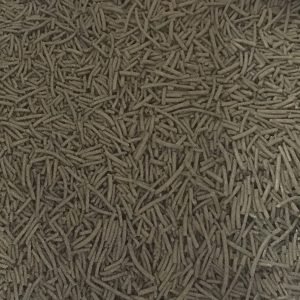
Rapemeal
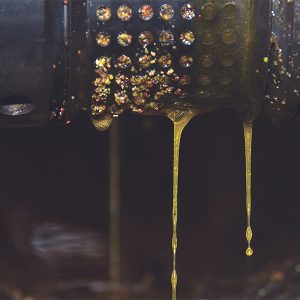
Rapeseed oil dripping from press
Once the seed has been pressed, the oil trickles out and is simply passed through a filter, a bit like coffee paper, before it is put into bottles. These bottles were then destined for Morrisons, the sponsors of 24 Hours in Farming, a lovely coincidence!
Returning back to the combine harvester, Duncan, Robert and Marvin had lots of barley to harvest, so ended up going until half 10 that night, it’s a good thing the combine has headlights! By the end of the day, we had managed to harvest all the barley, which we were VERY pleased with, especially as rain started to fall the minute after we had shut the combine into the barn, perfect timing or what! The weather often causes problems around harvest, the crops may be ready but if it’s raining, we can’t combine as the moisture levels must be low.
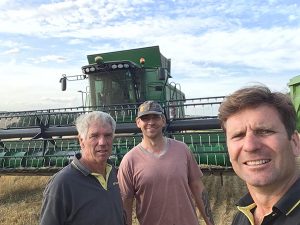
Duncan, Robert and Marvin after a busy day’s harvesting
Throughout the day, hundreds and thousands of British farmers and food producers shared images and videos from their day with #Farm24. It was a fantastic day for learning about how our food is produced. #Farm24 was trending for most of the day and over 8 million people saw the photos and videos shared throughout the day! For more information on 24 Hours in Farming, please visit Farmer’s Guardian here: https://www.fginsight.com/24hoursinfarming/sponsored—24hoursinfarming
The rapeseed crop has been grown in Britain for a number of centuries, in fact, it was first introduced to the UK by the Romans. Rapeseed is a brassica and is related to such plants as the cabbage, mustard and turnip for example. Rapeseed became a popular crop in the UK from the 1970’s, as farmers were encouraged to grow it due to increasing demand for a refined British rapeseed oil by food manufacturers, as an alternative to other imported refined oils. The oil also became popular in Canada and the USA and became known as canola oil.
Rapeseed continued to be used purely as a refined oil until 2005, when Duncan Farrington became the UK’s first seed-to-bottle producer of cold pressed rapeseed oil. After studying the oil as part of his degree, he was fascinated by the health and culinary benefits when it was cold pressed. So, in 2005 he set up a small press on his family farm and started cold pressing the rapeseed grown in his fields. The oil was a huge success and British cold pressed rapeseed oil is now a store cupboard staple for many households up and down the country.
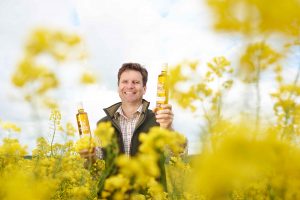
Benefits of cold pressed rapeseed oil
– Half the saturated fat of olive oil and ten times less than coconut oil
– Healthy balance of Omega 3, 6 and 9
– 10 times more Omega 3 than olive oil
– A rich source of vitamin E
– Contains plant sterols and phenols
– High smoke point of 230°C
– Subtle, nutty flavour with buttery notes
Producing British Rapeseed Oil
We are so proud to produce British rapeseed oil. As we grow, press and bottle our Mellow Yellow oil on our farm in Northamptonshire, it is truly British. Normally planted in August, a rapeseed crop is incredibly difficult to establish as it needs perfect conditions for it to survive the first couple months as it emerges through the soil. To ensure success the crop requires a combination of good soil nutrition and structure; moisture in the soil (but not too much); warm soils, ideally over 9°C; no pests, especially Cabbage Flea Beetles and Slugs, both of which find newly emerged tender leaves incredibly delicious and can decimate a crop in a matter of days. Later in the winter months, pigeons also enjoy eating the leaves which we try to stop with bird-scarers.
If the farmer’s skill, along with a bit of mother nature’s help get the crop through to the spring, then rapeseed starts looking after itself as the days lengthen and the weather warms. From late February onwards it starts waking up and literally grows before your eyes, going from a small cabbage like plant to something over a metre tall in a matter of weeks. By April the crop starts flowering, giving the countryside the recognisable yellow fields. The flowers are pollinated by native bumble bees, to produce the tiny black seeds ready to harvest some eleven months after the crop was first planted.
As well as the weather affecting the growth of the rapeseed crop, weather conditions at harvest time also affects the quality of the finished oil. Ideally the seeds need to be harvested in cool dry conditions, as moist warm conditions will spoil the crop and encourage the growth of moulds. Once harvested, the seed is stored with the moisture and temperature carefully controlled to ensure the seed is keep in the best possible condition, ready to be cold pressed to make a deliciously healthy, quality British rapeseed oil.
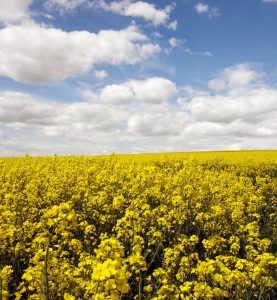
Where to buy British Rapeseed Oil
Farrington’s Mellow Yellow Rapeseed Oil is available nationally from Booths, Morrisons, Ocado, Sainsbury’s, Waitrose and many independent farm shops and delis. In order to find your local stockist, visit our Where to Buy page and just enter your postcode.

Bottom Farm is an arable farm, in other words, we grow crops and not animals. However, when giving talks on sustainable agriculture, I sometimes say that we do have livestock on Bottom Farm in the form of worms, pollinating insects, beetles and a whole host of other beneficial little creepy crawlies that help me grow my crops. They help by recycling old plant debris to create plant food for the growing crops in the case of worms; or pollinating our rapeseed and beans in the case of pollinating insects; or indeed helping with my pest control, in the case of the beetles that eat unwanted aphids on the crops. But in the more traditional sense, we don’t usually have livestock on the farm.
As part of a good sustainable farming system, I grow a healthy rotation of different crops around the farm each year. The basis of this being that different crops take different things from the soil and put different things back. In addition to growing different crop types, we also plant crops at different times of the year which helps in breaking weed and disease cycles. Generally, we plant crops in either the autumn or the spring.
Before planting a spring crop of say, barley, I plant a cover crop in the autumn. A cover crop does just as it says, it covers the ground, protecting the soil from winter rains. By growing a crop throughout the winter months means the growing roots are holding onto precious minerals rather than being washed away in the rainfall. The roots also keep the soil in good structural condition, keeping it lovely and friable for the following spring crop. Finally, the growing crops provide a food source for all those little creepy crawly animals and bacteria in the soil that work altogether to make a healthy fertile soil.
I have tried several different crops over the years and currently favour a mixture of crop species, this includes oats, vetch, phacelia and buckwheat for example, each adding their own little bit of magic to the mix. Generally, I plant the cover crops in August or September and allow them to grow until January or February. As soon as the weather conditions allow, we will apply a herbicide to the crop to kill it off, giving it time to die and breakdown in readiness for the spring barley to be planted in March or April. By giving time for the crop to breakdown, all the bugs in the soil will start converting some of the plant material into nutrition ready for the new planted barley to feed on and grow healthily into a crop to be harvested.
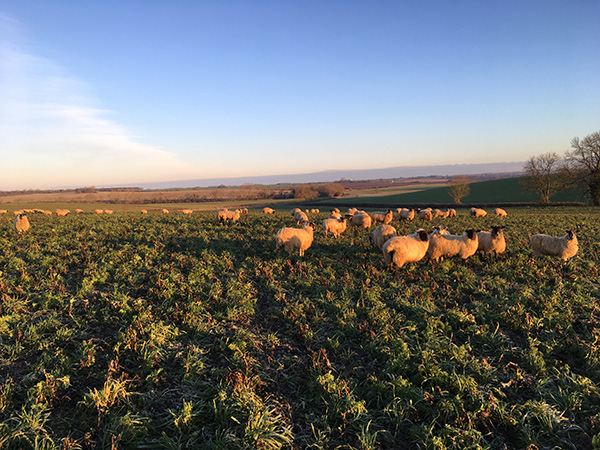
However, let’s return to the topic of livestock on Bottom Farm! Over the last few years, on some of the cover crop fields I have used sheep to graze off the vegetation in readiness to plant the following crop. This traditional method of destroying the cover crop is sometimes called the ‘golden hoof’, as the sheep not only remove the crop, but in the process, convert it into a fresh source of manure, thereby fertilising the soil. The sheep are not mine, but belong to a local farmer who takes them from farm to farm, where he gets good quality grazing for his flock, whilst providing us with an excellent lawnmower and fertiliser service. It does mean for a few weeks a year, I become a livestock farmer and we have sheep on Bottom Farm. I thoroughly enjoy walking the field every morning to check they are all still there and happily grazing. You could say it makes me feel like a real farmer, using traditional methods in our very modern world.
You can learn more about our sustainable farming practises here.

Duncan Farrington
“A nation that destroys its soils destroys itself”
Franklin D Roosevelt.
As a farmer, I have always known that everything I produce is dependent on the soil I grow my crops in and the rain that falls on them. Without these natural resources, we would fail. However, it is not just farmers that soils are important to. They are the cornerstone for the survival of life on earth and, as former American President Roosevelt appreciated, the key to the prosperity of whole nations and civilizations.
Ever since mankind turned from hunter gatherer to farmer, we have had the sad record of destroying our soils, which led to the demise of empires. Whether this being the Ancient Greeks, where ancient monuments are now surrounded by arid bedrock, in what was once fertile farm land. Or the fall of the Roman Empire, which spread out north and south from Italy, in the attempt to bring food in from new agricultural lands. Or more recently the fall of the Soviet Union, as the population got fed up with constantly queuing for essential staple foods, where in reality they were not producing enough food to feed themselves.
In nature crops and animals grow naturally quite well, but they are a bit randomly spread out. As mankind started to domesticate crops and animals for their needs, they started clearing areas of land to produce more food in a given area. The land was cultivated by the plough, originally a small implement pulled by an ox or donkey, today it is much larger and pulled by tractors. But the principle is the same. The plough turns over and breaks up the soil surface to create a seed bed to plant crops in. The advantages are that it provides soils free from weeds, provides good conditions and soil structure for plants to grow in. It also gives a nutritional boost to the plants as bacteria breakdown minerals for the plants to feed off.
Over time the disadvantages of ploughing however outweigh the advantages. The freshly disturbed surface of the earth is very fragile, especially when it rains, with soil erosion being particularly noticeable on slopes. As rain drops hit the soil surface, water drains down-hill into streams, rivers and eventually into seas and oceans. But the water takes the fertile soil particles with them, which in time can remove the soil completely; think of those ancient Greek monuments standing on top of rocky outcrops. But it still happens today as this satellite image of the UK clearly shows. Now whilst I am all for us exporting more products to our friends in Europe, I am not sure we want to be sending them our fertile soil.
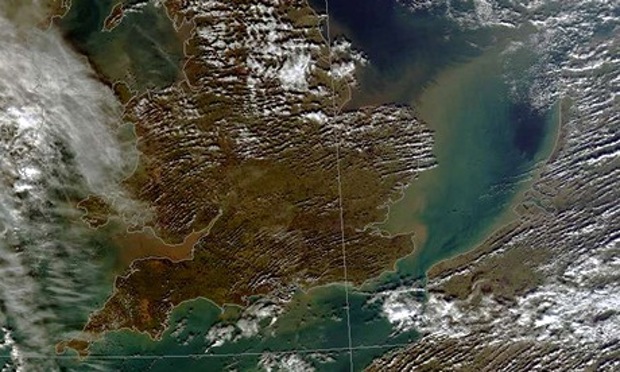
This satellite image, taken on 16 February 2014, shows how soil is washed off our fields and out into the sea. ©NEODAAS/University of Dundee
Also, whilst ploughing creates a lovely loose structure for seeds to germinate in, the action of ploughing exposes the soil to oxygen in the atmosphere. This gets all the soil bacteria really excited, similar to a young child being given sugary sweets, running around really quickly, before collapsing in a heap on the floor once the sugar rush is over. The bacteria ‘run around’ in this high oxygen atmosphere, giving lots of nutrition to the crop, but it is short lived as the bacteria eat up the store of carbon in the soil, respiring as they do so, and thus release the stored carbon to the atmosphere as carbon dioxide. This has the double negative effect, of gradually reducing the nutritional content of the soil and increasing the global warming effects of increased CO2 in the atmosphere.
Having learnt much on soil quality over the years, I took the decision not to plough on our farm back in 1998. Admittedly, my incentive was not just to save the planet, but also to save money as ploughing is an expensive operation. Although it was known my crop yields could reduce a little, hopefully this would be more than compensated by reduced costs. When I stopped ploughing, I made lots of mistakes as yields reduced dramatically for a short period, as well as weed pressure increasing. Our neighbours thought I was a bit daft – they may be right on that one. But over the years, I have learnt an awful lot as the system has improved. The theory of not ploughing is that naturally plant roots and creatures like worms improve soil structure. The bacteria and other micro fauna improve the soil health and biology, converting old plant residues and mineral content of the soil into plant food. So by not ploughing, the soil structure and organic matter content gradually improves year on year and, the carbon from the soil is not released to the atmosphere as CO2. I continue to learn from my experiences as we are making a healthy environment for the plants to grow in, but this is the underlying theory.
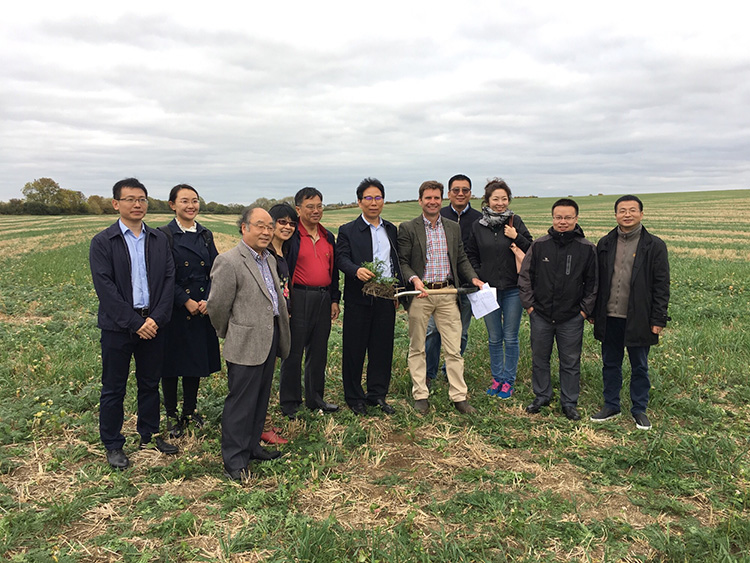
Delegation from China, including Deputy Director General of the Ministry of Agriculture and the Chinese delegate for the United Nations Environment team.
Today, soil health is something that governments around the world are realising is important and we should be doing something to improve our most important natural asset. I was especially proud recently when, along with LEAF, I hosted a delegation from China which included; The Deputy Director General of the Ministry of Agriculture and the Chinese delegate for the United Nations Environment team. They were very interested in what we are achieving with our soil health on the farm.
Plenty of commentators accuse agriculture of being a huge cause of global warming from CO2 emissions, however I can show from what we are doing on our farm, agriculture can play a major role in reducing CO2 emissions when looking after our soils.
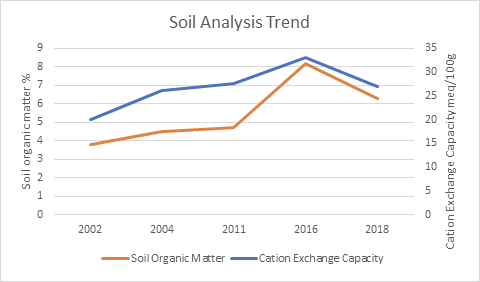
Below Black Barn field, Bottom Farm
The graph shows how the soil on our fields is improving in quality, by increasing in soil organic matter. To put this another way, we are actively absorbing CO2 out of the atmosphere and locking it into our soils. If this is repeated around the world, the benefits could be enormous; it has been estimated that agriculture could reduce global CO2 emissions by between 10% to potentially 30%. The graph also shows the increase in Cation Exchange Capacity (C.E.C). In basic terms as the CEC increases, there is more nutrition within the soil for the plants to grow healthily.
So, in the space of a few years of trying to work with nature, the results clearly show we are creating a healthier, more nutritious environment for crops to grow in. Not only is this good for the soil and the wider environment, but it is good for us also, as healthy soils grow healthy crops and healthy crops create healthy food for us to enjoy eating.
Learn more about our environmental credentials here and where to buy our LEAF Marque Cold Pressed Rapeseed Oil here.
In May this year, when our rapeseed fields were looking their best in full bloom, Nadiya Hussain and a filming crew from Hungry Gap Productions came to Bottom Farm to learn more about how we produce our cold pressed rapeseed oil. The reason for the visit was to film a segment for Nadiya’s new series, Nadiya’s Family Favourites!
Starting in the fields, Duncan explained how he grows the rapeseed to LEAF (Linking Environment and Farming) Marque standards and how the plant grows. He then showed Nadiya the cold pressing method we use and how we bottle our oil.
As Nadiya is obviously a brilliant baker and chef (she won the Great British Bake Off in 2015) she was keen to learn more about cooking with Mellow Yellow Cold Pressed Rapeseed Oil! So she headed off to The Mermaid in Ellington and head chef, Nick Marriot put her taste buds to the test with a roast potato challenge. After cooking roast potatoes in either cold pressed rapeseed oil, sunflower oil or olive oil, Nick challenged Nadiya to identify each oil. With it’s high smoke point giving super crispy roasties and subtle nutty flavour, she easily spotted the ones cooked in Mellow Yellow!
We absolutely loved having Nadiya visit us at Bottom Farm, it was a fantastic day and watching ourselves on TV is incredibly exciting! If you didn’t catch the episode live last week, you can catch up on BBC iPlayer now: https://www.bbc.co.uk/iplayer/episode/b0bc26qk/nadiyas-family-favourites-series-1-1-family-days-out
Nadiya’s Family Favourites is on BBC2 every Monday at 8pm.
I have been asked in the past what we do in the winter months. People comment, saying “Surely as an arable farmer, you plant the crops in the autumn, go away on holiday and come back the following summer ready to harvest them?” Nice thought, but I’m afraid the reality is a little different.
Admittedly, on an arable farm, where we only grow crops and do not have any livestock to look after, the winter months are quiet and it can be an opportunity to relax on a holiday if you wish. However, I have always found it the time of year for research, planning and projects, of which we have done many over the years. Back around the millennium, I remember spending many winter months researching the viability of creating a cold pressed rapeseed oil business on our farm, as a diversification project on something I found very interesting and to hopefully bring a little extra income to the family business. Looking back, I think this was time very well spent.
Of course winter is an ideal time for us to service all the farm machinery in preparation for the coming spring and summer months when we will want it to work long and hard without too many breakdowns. We have done many building projects over the years, both for new machinery ideas and for buildings on the farm. Some examples have been building a new trailer, or creating a water bowser. In the past, when I was a young boy and even before I was born, my Father and Grandfather were at their happiest creating new weird and wonderful machines in the farm workshop. Two of the most extravagant examples included a six-wheel drive tractor, converted from a World War II army fire engine. I remember going across the fields with them on this machine, before it finally over heated and was retired in the nettles. Their most famous project was when they took two normal tractors, replaced the standard engines with more powerful versions, before removing the front axils off both tractors and joining them together to make an articulated four-wheel drive machine, driven by one person from the back tractor. This was certainly cutting-edge engineering in its day, that was later copied and refined by machinery manufacturers in future years.
We have restored our beautiful traditional barns and converted them from redundant old farm buildings into offices, including our farm office today. New modern grain stores have been designed and built to cope with storing and drying the grain at the speed the modern combine harvester brings the crops in. Over the years, we have built all of the factory and some of the machinery inside it for Farrington Oils. Some of these projects seem to start as winter job ideas, but tend to stretch through other months of the year and before long take on a whole life of their own. The most recent being the latest expansion of Farrington Oils to create a new toilet and changing facilities, as well as extra space to mix our salad dressings and store ingredients. We have even made a little development kitchen in which Eli is currently very busy with her trusted jam jar creating some possible exciting new dressing recipes. This whole project started in April last year, we had a few weeks break for harvest to take place, before finally finishing the project just before Christmas.
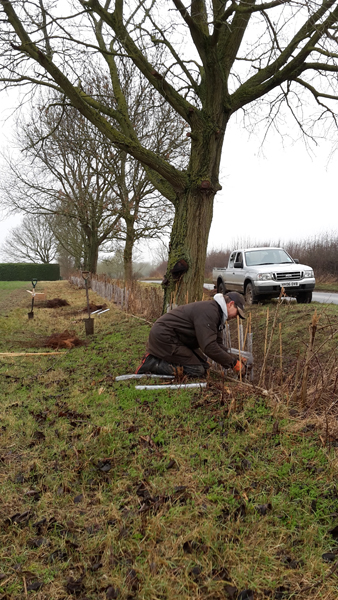
Marvin planting saplings in Jan 2018
The other main type of project we have done during winter over the years is planting trees and hedges. We have literally planted thousands of trees and several kilometres of hedges since 1987 when my Father planted the first couple of spinneys on the farm. They are now well established, adding beauty and wildlife habitats to the landscape. This year we have been at it again. Marvin spent the time before Christmas with the chainsaw, thinning out dead wood from a copse area and old hedge, in readiness to replant with new young saplings in the first weeks of January. He has now created a few hundred more metres of hedgerow – Father and I have helped him with the spade to get some of the 2,000 hedge and tree plants put into the soil. We will have to weed around the young saplings for the first two years, after that they will hopefully grow and thrive, adding more beauty and wildlife habitat for many years to come. Additionally, we have a pile of wood ready to cut up for the fire to keep us warm at home next year.
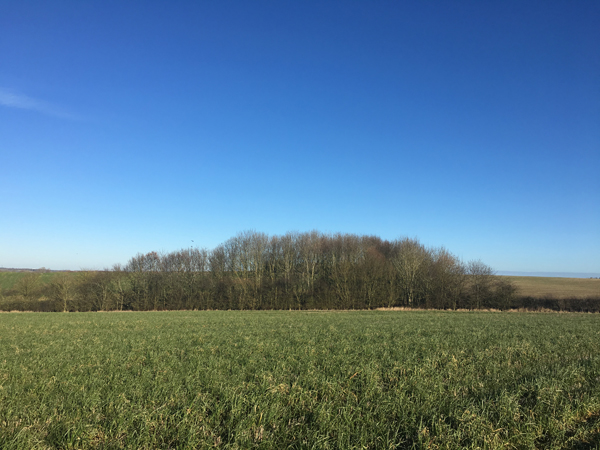
Spinney on Bottom Farm that was planted in 1987, photo taken Feb 2018.
Although winter on Bottom Farm may not be spent on a combine harvester or tractor, it certainly is far from quiet!
